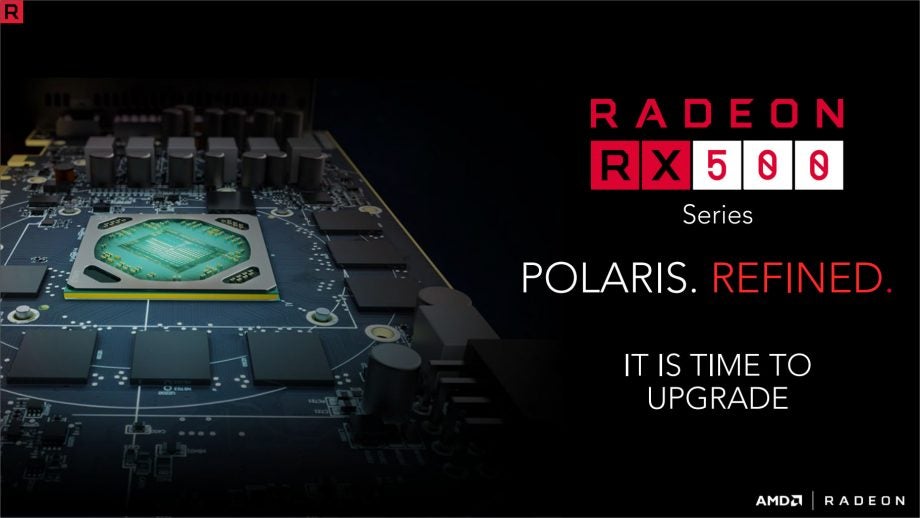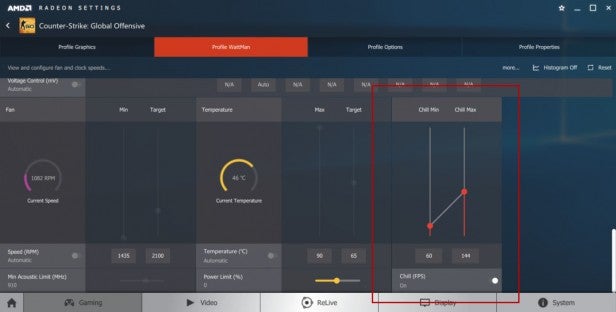AMD launches three new graphics cards – RX 580, 570 and 560 revealed

AMD has unveiled a trio of new graphics cards based on refined versions of the Polaris GPUs used in last year’s RX 400 series cards.
The RX 580, 570 and 560 are each direct upgrades to the RX 480, 470 and 460 and bring with them improved clock speeds, lower power consumption for around the same price. If you’re thinking about buying a 400-series card, think again.
This puts the cards into a similar mid-range performance bracket as before, with AMD pitching the RX 580 as a competitor to the Nvidia GTX 1060 and the RX 570 lining up against the GTX 1050 Ti. Overall, AMD sees the new RX 500 series as a natural upgrade for those with graphics cards more than two years-old.
The company also announced an ultra-budget GPU, the RX 550, designed for extremely cheap PC playing low-end eSports games.
These are not AMD Vega cards, however, instead using ‘Polaris 20 XTX’, which is a refresh of the pre-existing ‘Polaris 10’ architecture used in the 400-series chips. Vega is yet to launch and is expected to compete with Nvidia at the high end of the graphics card market. Especially after the success of AMD’s brand new Ryzen CPUs. Instead, it is expected that Vega will launch some time in the second half of the year.
The RX 580 and 570 go on sale today, while the eSports-friendly RX 560 will go on sale early in May. The 550, meanwhile, will go on sale on April 20.
Related: AMD Ryzen 5 review
AMD Radeon RX 580 Specs
| Radeon RX 580 | Radeon RX 570 | |
|---|---|---|
| GCN Architecture | 4th Generation | 4th Generation |
| Manufacturing Process | 14-nm FinFET | 14-nm FinFET |
| Die Size | 232 mm2 | 232 mm2 |
| Compute Units | 36 | 32 |
| Stream Processors | 2304 | 2048 |
| Clock Speeds (Boost / Base) | 1340 MHz / 1257 MHz | 1244 MHz / 1168 MHz |
| Peak Compute Performance | Up to 6.17 TFLOPS | Up to 5.1 TFLOPS |
| Texture Units | 144 | 128 |
| Peak Texture Fill-Rate | Up to 193.0 GT/s | Up to 159.2 GT/s |
| ROPs | 32 | 32 |
| Peak Pixel Fill-Rate | Up to 42.9 GP/s | Up to 39.8 GP/s |
| Memory Size | 8 GB | 4 GB |
| Memory Bandwidth | 256 GB/s | 224 GB/s |
| Memory Interface | 256 bit | 256 bit |
| Memory Type | GDDR5 | GDDR5 |
| Board Power | 185W | 150W |
| AMD FreeSync™ Technology | Yes | Yes |
| DirectX® 12 Support | Yes | Yes |
| Vulkan™ Support | Yes | Yes |
| DisplayPort Version | 1.3 HBR / 1.4 HDR Ready | 1.3 HBR / 1.4 HDR Ready |
All three RX 500 series cards feature the same number of compute units, stream processors and texture units as their predecessors and they’ll come with the same memory configurations. In simple terms, these are the troops on the ground doing all the graphical legwork.
This leaves clock speed (number of operations per second) and power consumption as the only major changes. Regards the former, the RX 580’s base clock speed has gone from 1120MHz to 1257MHz, which is a 12% improvement. Meanwhile the RX 570 sees a larger 26% boost.
As for power consumption, at idle the RX 580 8GB uses 11.9W compared to 17.4W for the RX480 when outputting to a single display. This is a decidedly unsexy figure that’ll make the difference of a few quid less on your electricity bill over a year, but not much else.
These improvements are down to two factors. The first is refinement of the 14nm FinFET manufacturing process used to make the GPUs. Continual tweaks improve yields and average performance allowing AMD to clock more of the chips at a higher speed while running at a lower voltage.

Further power consumption improvements come from the introduction of a third ‘intermediate memory state’ between the high performance and lower power states of the previous RX 400 series. The biggest beneficiary of this is dual-monitor setups, where AMD claims idle power consumption has dropped from 25.2W for the RX 480 to 13.4W for the RX 580.
AMD is also tackling power consumption on the software side with Chill, a new addition to its Radeon Settings software. This monitors user input while gaming and reduces the framerate when the user is mostly static, instantly ramping it back up again when the user begins moving. AMD claims a reduction in power consumption of up to 31.5% on the RX 580 when playing DOTA 2.
The RX 500 series are availability immediately with MSRPs of £219.99 inc. VAT for the RX 580 8GB, £184.99 inc. VAT for the RX 580 4GB and £164.99 inc. VAT for the RX 570 4GB. That’s largely in the region of the 400-series equivalents, which makes sense given these 500-series cards a direct replacement for them. Look out for deals on 400-series cards, though, as they could come down in price.
Will you be taking the plunge with Polaris 20 or are you holding out for Vega? Let us know in the comments below.

